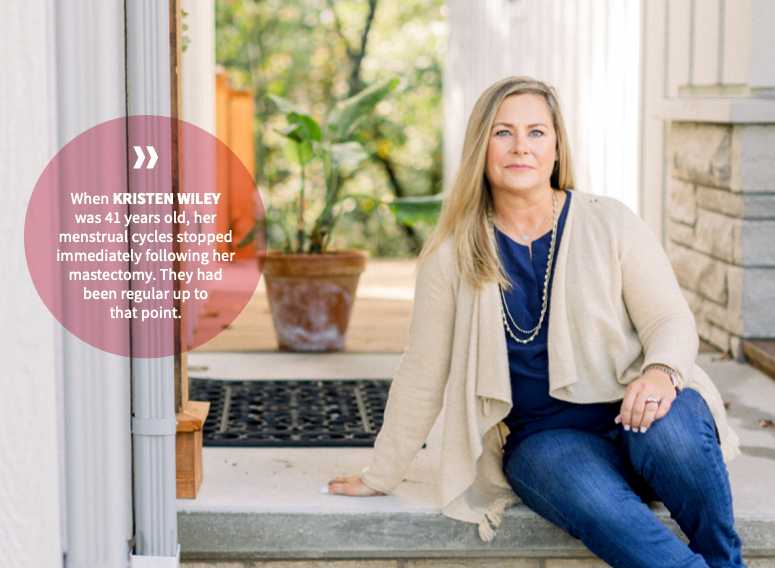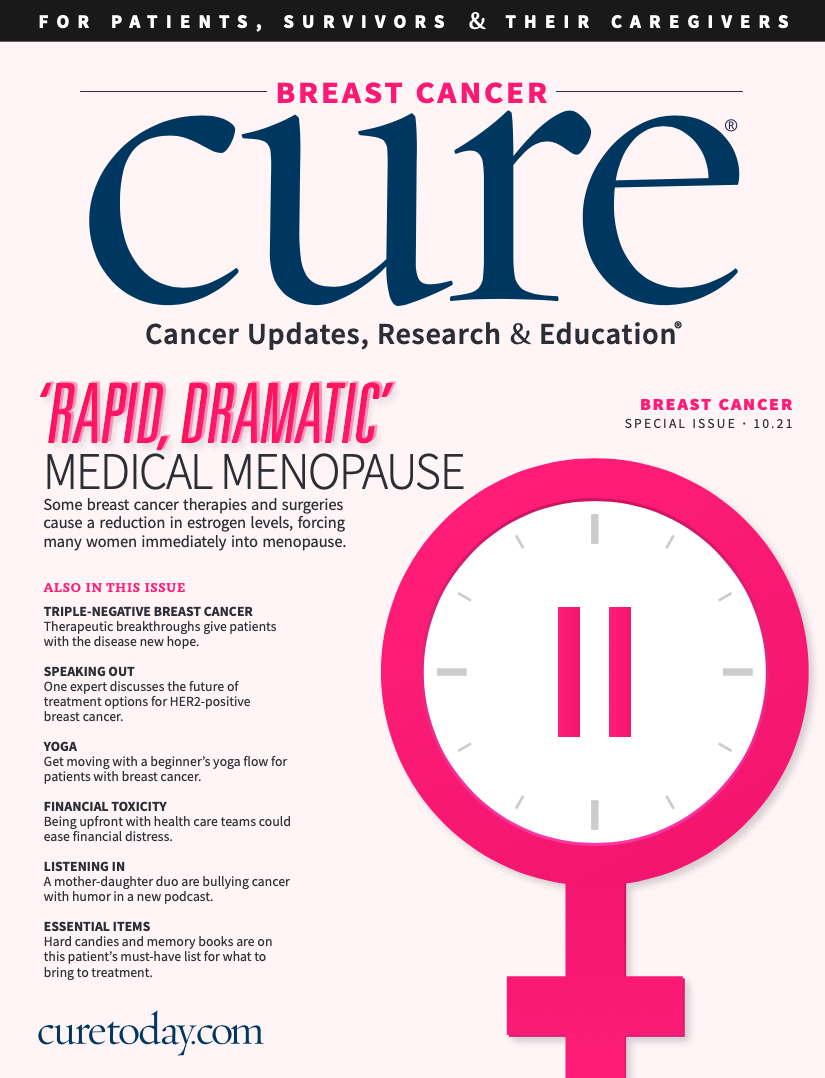Publication
Article
CURE
Breast Cancer Treatments Propel Many Women Into 'Rapid, Dramatic' Medical Menopause
Author(s):
Some breast cancer therapies and surgeries cause a reduction in estrogen levels, forcing many women immediately into menopause.
In October 2011, Kristen Wiley found a pea-sized lump in her breast. Having had a clear mammogram just seven months earlier, she thought it would go away.
When the lumps were still there in December, Wiley decided to go to her doctor at Mayo Clinic in Jacksonville, Florida. “She said, ‘I’m sure it’s nothing, but let’s be safe and do another mammogram,’” Wiley recalls her doctor telling her. The doctor also performed an ultrasound and biopsy. In January 2012, Wiley, then 41 years old, received a diagnosis of triple-positive breast cancer, which meant her tumors were human epidermal growth factor receptor 2 HER2-positive, estrogen receptor (ER)-positive and progesterone receptor (PR)-positive. This means the treatment like hormonal or HER2 antibody therapies would not be effective, and that the tumor was likely to be more dangerous.
When Kristen Wiley was 41 years old, her menstrual cycles stopped immediately following her mastectomy. They had been regular up to that point.

“I was a picture of health,” she says. “No family history of breast cancer. I was very active and fit. It completely took us by surprise.” Wiley, who had a 3-year-old daughter, decided she would go “full throttle” with her treatment after learning how aggressive her disease was. Her cancer was stage 2, and three lymph nodes were affected by the disease. Wiley had a double mastectomy with reconstruction, and over a 14-month period she underwent 29 rounds of chemotherapy, 27 radiation treatments and five surgeries.
Immediately after her mastectomy, her menstrual cycles — which Wiley describes as regular until that point — stopped. She began to have hot flashes hourly, seven days a week. “I would go from fine to bright, cherry red and pouring sweat within five minutes,” Wiley, now 50, says. Throughout treatment, she continued to work full time as a senior managing director for a global financial technology company, but the menopause-induced hot flashes and mood swings were difficult to hide because they would spring up without warning.
"I was a picture of health. No family history of breast cancer. I was very active and fit. It completely took us by surprise." - Kristen Wiley.

JOLTED INTO MENOPAUSE
For most women in the United States, the average age of menopause is 51. But, like Wiley, many women with breast cancer can be propelled into medical menopause following treatment for the disease. All women who have an oophorectomy, a surgery to remove both ovaries, will go into immediate and permanent menopause if they weren’t menopausal before the surgery because the ovaries are no longer there to produce estrogen. In addition, up to 40% of women under age 40 and anywhere from 70% to 90% of women over age 40 go into permanent menopause because of chemotherapy, according to breastcancer.org. For other women, the loss of ovarian function is temporary.
For patients who are premenopausal, “some of the chemo- therapies are toxic to the ovaries, and the older women are, the more likely these agents will cause ovarian failure,” says Dr. Stephanie Faubion, director of Mayo Clinic Women’s Health and medical director for The North American Menopause Society (NAMS). “Early menopause caused by surgery is rapid and results in a sudden and dramatic decline in estrogen levels. Women are often very symptomatic with hot flashes, night sweats, joint aches, mood disturbances and sleep disturbances.”
Other symptoms of menopause include anxiety, depression, fatigue, brain fog and weight gain. Women may also experience bone loss and vaginal dryness, which can lead to painful intercourse. Vaginal dryness usually occurs in the months after menopause onset, according to Faubion.
Rebecca Seago-Coyle says she felt isolated after experiencing a lack of desire and vaginal dryness, which she says took a toll on her relationship with her husband. “I was in my 30s and wanted an active sex life,” says Seago-Coyle, who received a stage 1 ER-positive/HER2-positive breast cancer diagnosis in 2010 when she was 35. At the same time, she learned she was BRCA2-positive — a gene mutation she inherited from her father. Women who have BRCA mutations are at an increased risk of certain cancers — most notably, breast and ovarian cancer — and for developing them at a younger age, while men with BRCA2 mutations are at increased risk for breast cancer.
Rebecca Seago-Coyle says she felt isolated after experiencing a lack of desire and vaginal dryness, which she says took a toll on her relationship with her husband.

Seago-Coyle’s cancer was labeled aggressive because of the grade and tumor size. She was treated with 12 weeks of Taxol (paclitaxel) and a year of Herceptin (trastuzumab). She also underwent bilateral mastectomy with reconstruction and had her ovaries removed to decrease changes of recurrence. “I don’t think anyone prepares you for menopause,” Seago-Coyle says. “Medically induced menopause in your 30s is different (from what) the average person goes through gradually. When it happens medically, it’s a jolt.”
THE PHYSICAL AND EMOTIONAL BURDEN
All of these symptoms can be stressful, as they are constant reminders not only of what is happening to the body at that moment but also the cancer itself. They can reduce day-to-day quality of life, which can be difficult for someone to navigate.
“Hot flashes, mood changes, body image, self-esteem — all of these things that may naturally happen with menopause later in life are happening for some women much earlier, so this could be at a time when they’re thinking about having families, or have young children, or being in the workforce more, and the day-to-day can take a toll on people emotionally, mentally and physically,” says Lauren Chatalian, a licensed clinical social worker and women and children’s program manager for CancerCare.
Seago-Coyle enjoys reading and practicing yoga every night before going to bed. It helps her to fight restless sleep — a side effect of menopause.

Hormonal therapies that suppress estrogen levels can also cause side effects of menopause. When Wiley began taking aromatase inhibitors (AIs), more of the symptoms kicked in. She was first put on Arimidex (anastrozole), but it caused weight gain, so she switched medications to Femara (letrozole). However, she then began to have severe bone pain.
“It was like someone took a hammer to my toes and fingers and crushed all my bones overnight,” Wiley remembers. “You would feel like you were (being hit with) a meat tenderizer. I can take a lot of pain, but not this much.”
Her oncologist switched her AI a third time to Aromasin (exemestane), but that also caused bone pain. Wiley went back on Arimidex, which she says caused her to gain 30 to 40 pounds. But the extra pounds were a trade-off for less pain.
“When we think of menopause, we think about middle adulthood. You’re diagnosed and experiencing mixed emotions, prepping for treatment, surgery — and it goes fast, it’s hard to slow down,” Chatalian says.
In facilitating support groups for CancerCare, Chatalian advises women with breast cancer who experience menopause related to cancer treatments to have a conversation with their medical team and their loved ones about the life-disrupting symptoms and let them help.
Seago-Coyle ended up needing additional support. “My medical team had the best intentions, but it’s also feeling comfortable enough to share,” she says. “It’s hard to explain to other people because they interpret it in different ways. When I was going through chemotherapy, I went to a support group and learned how to talk more openly. These women shared tips and tricks.”
In addition to support groups, Chatalian encourages self-care, such as focusing on stress relief, using relaxation techniques, reading or journaling.
To fight restless sleep, which Seago-Coyle attributes to menopause, she created a routine that involves reading and doing yoga every night before bed. She also takes a natural supplement with magnesium and an Advil PM, and she is in bed by 8 p.m.
Wiley turned to an informal support group — two friends who received breast cancer diagnoses after she received hers. In addition, she became active with The DONNA Foundation, which supports families who are trying to make ends meet financially following breast cancer, thanks to a friend who introduced her to the group. She runs in the foundation’s annual marathon to help raise money and awareness for the cause.
On the home front, Wiley switched to cooling pillows and mattresses, and she doesn’t leave the house without a handheld fan. “I carry two in my purse at all times,” she says.
HOW TO TREAT SYMPTOMS
Pharmacologic options can help reduce menopause symptoms. For instance, results of several studies have shown that medications such as Effexor (venlafaxine), Neurontin (gabapentin) and Oxytrol (oxybutynin) may reduce the frequency and intensity of hot flashes. The only drug approved by the Food and Drug Administration to treat hot flashes associated with menopause is Brisdelle (paroxetine), which is an antidepressant. “Many of the antidepressants have been studied for hot flash management, and none of them have much more than a 40% to 50% reduction in symptoms,” Faubion says. “These are not magic cures. They take the edge off hot flashes.”
Researchers in phase 3 clinical trials are investigating NK3 inhibitors, which are a promising new class of drugs that target neurons in the brain’s hypothalamus responsible for hot flashes. Specifically, they take aim at the neuron complex kisspeptin/neurokinin B/dynorphin, known as KNDy neurons. Study results have shown an approximate 90% reduction in hot flashes in a couple of days compared with placebo at 25% to 30%.
Alternative therapies such as hypnosis and cognitive behavioral therapy have evidence to support their use for hot flash management. And in some cases, acupuncture has been more effective than medication, according to Dr. Amy Tiersten, a professor and clinical director of breast medical oncology at Mount Sinai in New York City.
Nonhormonal lubricants and moisturizers are initially offered to women who have vaginal dryness. But if those don’t work, low-dose vaginal estrogen can sometimes be considered after breast cancer survivors consult with their oncologists. Vaginal dilator therapy, which gently stretches vaginal tissue, and pelvic floor exercises to stretch and relax pelvic muscles may boost pelvic blood circulation and help relieve discomfort with sexual activity.
In women who experience joint pain following treatment with AIs, Cymbalta (duloxetine) may be prescribed. Bone- strengthening medications, such as Zometa (zoledronic acid), are often suggested for women taking AIs. “Not only do these bone-strengthening agents protect your bones from the negative effect on bone density from the aroma- tase inhibitors, but some studies show they also reduce the risk of the breast cancer coming back,” Tiersten says.
Typically, most patients are on anti-estrogen therapy for at least five years, but it could be as long as 10 years. The decision is made by looking at risk of recurrence and how well the drug is tolerated, according to Tiersten.
FIND A SUPPORT SYSTEM
Perhaps the most beneficial thing a patient can do is to find a physician who specializes in helping women through menopause. NAMS has an easy-to-navigate menopause practitioner finder on its website.
If patients want to address symptoms without medication, they can lean on resources available at their cancer center in addition to finding nonprofit organizations that offer support. For instance, CancerCare offers in-person and virtual support groups.
“This is going to be disruptive, and I don’t wish it on anyone. But your mental outlook is key to your success,” Wiley emphasizes.
And when those feelings of isolation creep in, Chatalian wants patients to remember they’re not alone.
“Take it one step at a time,” Chatalian says. “You are your best advocate. For any symptoms that arise, have a discussion with your medical team. Have questions prepared. And know there is support available for all the mixed emotions.”
For more news on cancer updates, research and education, don’t forget to subscribe to CURE®’s newsletters here.




